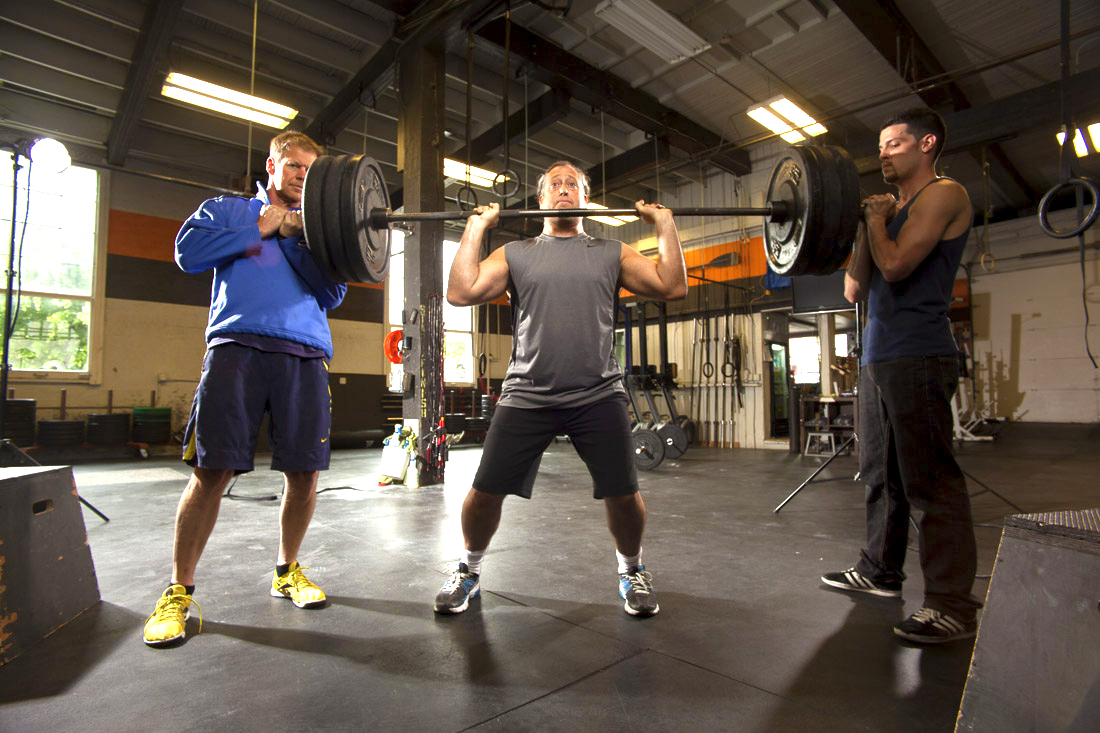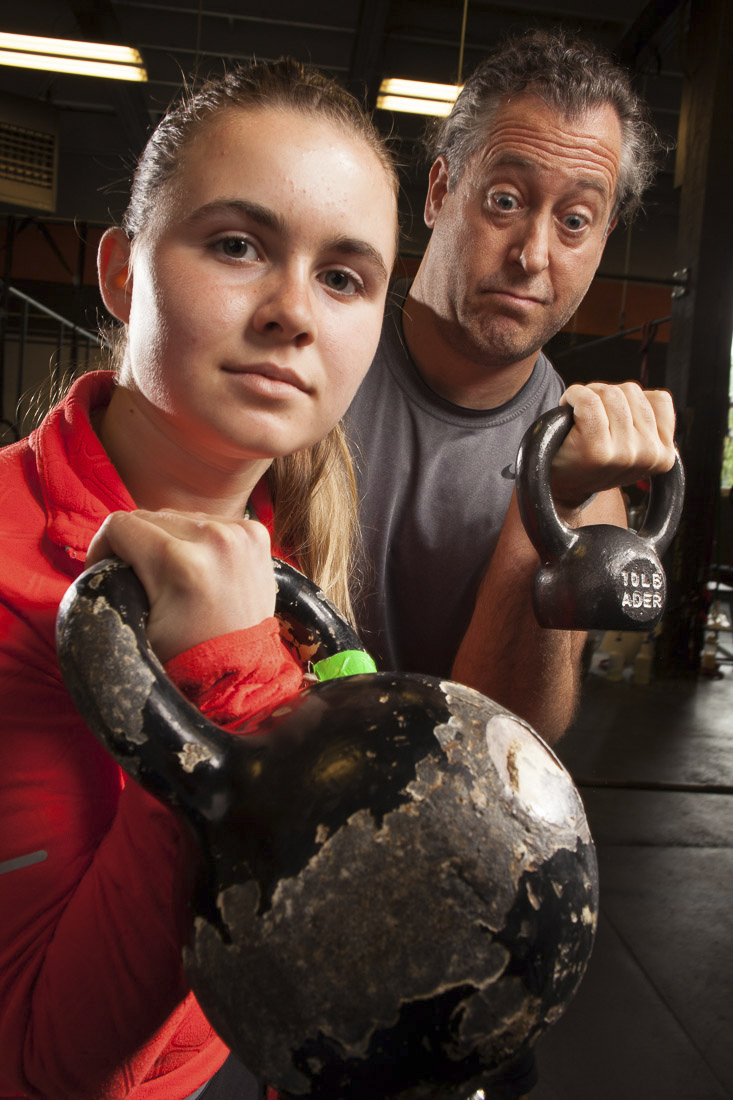Dogs are barking wildly at the doggy day care next door as I peer into the CrossFit West Seattle gym. Inside there is what looks like a deranged beefcake’s mad laboratory: indecipherable scrawlings on a whiteboard mixed with military flags, ropes and metal bars of all kinds, punching bags, dumbbells, and a black plastic floor that could just as easily catch pig guts as blood, sweat, and tears. Then there is the music—thumping Metallica crotch-rock.
CrossFit has become wildly popular; the Admiral gym near my house opened in 2009, and now there are four in West Seattle alone and over 140 statewide. Nationally, the number of licensed CrossFit gyms grew from 13 in 2005 to over 6,000 today. In a group bootcamp setting, the gyms provide varied—and often bizarre—workouts including high-intensity lifting, tumbling, sit-ups, rope-climbing, pull-ups: basically everything I hate about working out.
I’ve walked by this space a hundred times and watched people squat and grunt inside, with the occasional guy sprinting out the door while hefting a sandbag or flipping a giant tire. Peering into the gym—converted from an old auto-detailing shop—I figure I might as well give it a shot.
Seventeen men and women, ages 19–59, show up for my first CrossFit meeting: something called “Foundations,” an intro series to understand the language and core movements necessary to be able to subject yourself to torture.
Welcoming us all to initiation that day was the gym’s owner, Rob Martin. If you could pick one teammate for Survivor, it would be Martin. Ruggedly handsome, the 47-year-old is calm, clear-eyed, clearly strong as shit and a family man. His 17-year-old daughter, Lexi, runs the back office (and could probably lift me over her head). His son, Nate, 14, is also a gym rat, and frequently demonstrates proper gymnastic technique.
As two trainers swing their sculpted arms and twist their perfect torsos, Martin speaks briefly about the CrossFit philosophy. “As you can see,” he explains, “we don’t really use any machines in our gym. It’s an open space, and we use all of it in a million different ways to work out each time you are here.” As he speaks, I look with dread at the nets, rings, and heavy weights that litter the cavernous room.
“The key to CrossFit is variety—we emphasize competency at all physical tasks, based on functional movements you do in your everyday life.” I don’t know about this fellow, but I don’t do a whole lot of pull-ups or rope-climbing at my house (though I have thought about bringing in a stripper pole). The rest of us spend more time lifting lattes to our pie-holes than hefting ball-and-chains great distances. Still, I get it—building your core muscles is a big part of Pilates, yoga, and any cross-training. It’s important to keep a healthy spinal cord.
“Look at the Olympic athletes,” notes Martin. “Who’s the most fit, or in the best shape? It’s not the marathoner who has a slender frame, or the weight-lifter, it’s the guy who does the decathlon—someone who can cross over into many activities.” So Bruce Jenner’s my role model now, just without the plastic surgery. “Don’t worry,” Martin told us, “we mix it up, and we make it fun.”
As Martin runs through the 10 CrossFit fitness “domains,” my mind drifts to The Hunger Games (or if you want, the original it was stolen from, The Running Man): strength, power, speed, flexibility, cardiovascular and respiratory endurance, accuracy, agility, balance, coordination. Then we did some burpees.
Burpees are a way to warm up, and something trainers use as a sort of bitch-slap if members arrive late, fail to put their names on the board, or aren’t listening. The burpee consists of flopping down to the floor, doing a push-up, then popping up and clapping your hands above your head. (As it turned out, the burpee would be my favorite activity of the entire experience . . . )
The three Foundations series trainers are articulate, attentive, and mellow. But more important, they are the most superb human specimens you’ll ever see: Ramrod-straight, perfectly proportioned—basically what you get when searching Google Images for “hot hardbody.” (Not that I’ve ever done that . . . ) Rob, Zach, and Danielle trade off explaining how to perform even the most basic human tasks, which, sadly, I am performing sub-optimally: standing, for example (too far back on my heels), breathing (too shallow), and bending over (pooched stomach, shoulders scrunched).
The trainers consistently preach about how any CrossFit activity can be tailored to a specific person or limitation. Before the group does a dozen push-ups, for example, Danielle shows us how to do them the prescribed way, one that’s less strenuous (knees on the ground), or the old-folks’ version (standing with your arms extended against the wall and leaning in and out). By the time she’s demonstrated the granny push-up, I’ve been holding a standard for five minutes and am feeling my elbows begin to decay. Twenty-five jumping jacks here, 10 pull-ups there, some sit-ups, a jog around the block, and I’m already breaking a serious sweat.
That first day, it takes me a while to wrap my mind around what the hell is going on at CrossFit. Why is there a countdown clock on the wall? What does the scribbling on the whiteboard mean? (“RX: 5 Burpees, 5 SU, Five Squat, 200m X 4/15 minutes.”) With only 20 minutes left in our first session, I believe we’ve made it out easy. Then it hits me: These bastards are going to start the clock and we are going to do the entire series, right then, four times in a row. Five burpees, five sit-ups, five squats, and a run to Bartells and back . . . four times in a row. While being timed. It’s called, grossly, a WOD: Workout of the Day.
“You guys ready?” asks Rob with an sly grin. He grabs the remote control for the stereo, cranks up the AC/DC (to 11), then counts it down: “Five, four, three, two, one . . . GO!”
Cue a workout maneuver we’ll call the “scramble and thrash.” The quickest to finish his WOD is a kid who floats through the workout like a mailman on a Segway on a Saturday (12 minutes and 29 seconds). I am in the middle of the pack at 15 flat, and a fairly out-of-shape gent a few years older than me takes 19 and a half minutes to get ’er done. We write our times next to our names, and during our cool-down stretch, Rob tells us to drink plenty of water and expect some soreness.
Talk about an understatement. I have not, apparently, used a majority of my muscles on a regular basis during my pre-CrossFit life. On the days between workouts, I can barely move, and it takes every non-sore fiber of my being even to think about attending subsequent sessions.
Shockingly, the entire group returns to the second Foundations class (which probably has something to do with the $249 fee), each of us as sore as the next (even the kid). Trainers laugh off our aches, suggesting ice, massage, aspirin, and growing a pair. And we all agree it’s a good kind of sore—the kind that says, “How ’bout you lay off the Doritos and finally live up to all those New Year’s resolutions you’ve been ignoring?” There are entire blogs devoted to what CrossFitters call Delayed Onset Muscular Soreness, and as one states: “We all know you kind of like it.”
Weight Pain
Heavy, unruly objects line the racks in the front hall of the gym. Some look like they belong in the gym, others like branding irons for a T-Rex. But for the majority of the introductory class, we’re assigned a far less glamorous piece of equipment: a wooden broom handle—aka a dowel.
Zach, a bearded Ben Affleck look-alike, tries to lighten the mood with stupid puns and gags throughout his demonstrations. Zach’s jokes consistently fall flat, and he has trouble understanding why. Though I don’t mention it, the main reason is because, in the spare moments we aren’t gasping for air, each of us are marveling at his flawless physique.
“It’s not a relaxed motion,” Zach says about the Dip ’n’ Drive, a technique for getting a heavy weighted bar from your knees to high above you. “It’s a violent act. You are dipping down and EXPLODING into a locked position above your head!”
We dutifully imitate the action, “exploding” the broom handles skyward, either dreaming or dreading the day we’ll have to do the motion with something heavier than household cleaning supplies.
Danielle, one of the kindly trainers, often assists during workouts with adjustments and tips. “Can you lift your elbows higher? No? OK! That’s a flexibility issue! We’re going to work on that! Can you squat a little lower so your butt is below your knees for this? No? OK! Hamstrings! I’ve got something for you we can work on later!” Always a sympathetic smile, and a bit of amazement deep within her that a human is unable to do such a simple movement . . .
I am trying not to be a smart-ass, but have to ask about all this emphasis on Olympic lifting: the explosive “sumo deadlifts” and “military presses” using barbells with weight plates on the ends. (Couldn’t we just leave it to the Russians or something?) “The lifts we do in class are all functional, stuff you do in your everyday life,” Martin advises. “When you pick up a box, that’s a dead lift. When you get out of a chair, that’s a squat. Trying to put something away high on a shelf? That’s a push press. The stronger you are, the longer you can keep doing these movements safely.” (I now consider my position playing Candy Crush on the toilet a “deep squat.”)
Though I view myself as being in fairly good shape, I have never done any real weight-lifting. The calloused hands and unruly nature of barbells and chalk and pumping iron always took a back seat to playing hoops or tennis or, over the past decade, a regular yoga practice. But if lifting is a part of becoming an elite athlete, I am willing to give it a heave.
Graduated from the dowels, we’re told to go to the rack of weights and select what’s known as a kettle bell. “The suggested weight for men is 25 pounds,” Zach mentions as we clumsily grab the bomb-like objects, “and women typically start with 15 pounds.” As I lean down to grab a 35-pound bell (“Hulk STRONG!”), I feel my lower spine seize and twist and scream, “Oh, hell no!” As I grip a 25-pounder, the base swings out of control and embeds itself in my shin. I set it down and grab a 15-pounder as two fellow male students look at me as though I am sitting in a child’s car seat. (I watch them hide grimaces as they drag their 25-pounders to the circle.)
For the next 20 minutes, we are instructed on the proper way to lift, hoist, and swing a kettle bell back and forth between our legs. The stance has to be just right so as not to strain the lateral knee joint; the neck and shoulders mustn’t overcompensate for the force that is supposed to be generated from the hips; and the spine has to remain straight and long so as not to herniate a disc or three.
It is during the kettle-bell swing that I first realize CrossFit may not be for me. Regardless of the weight or my strength, repeatedly swinging a large steel object up and down and between my legs is not something I feel is a good idea. Could it strengthen my back and firm my core? Yes! Could this herking metal glob also throw me out of alignment at a moment’s notice? Uh, yeah. (While we are being instructed on a “limited” version of the swing, the long-term goal is a move called The American in which the bell swings all the way overhead—which should be christened the Mr. Yuk movement for back surgeons everywhere.)
The Caveman Cult
Eric Renn, the co-owner of this CrossFit, runs the last few Foundations classes. With an upbeat personality and abundance of health-spun knowledge, Renn is like Opie on Super Green Algae Supplements. “The CrossFit program is more than a workout,” Renn notes, as we cool down after our WOD. “We talk a lot about the cross-training and the proper technique, but we also need to discuss what you put into your body,” Renn says, staring at my midsection. “Everybody’s different, and you can obviously do what you want, but we suggest only eating what cavemen ate.”
For those who don’t know about the Paleo Diet, it’s basically all the meat, fish, seafood, eggs, and vegetables you can get your incisors around; some fruit; and none of the grains, legumes, dairy, starchy veggies, processed foods, sugar, or sweeteners. (Basically, death.) I’m old enough to understand this, but have no interest in giving up coffee and cheesecake and vodka tonics. Still, it makes sense that diet is part of the game plan. “If you do this, we’ll turn your Fiat into a Ferrari.” Knowing my history, I’ll be driving something more sensible, like a Volvo station wagon filled with unleaded wine and Ben and Jerry’s in the tank.
The diet and devotion to treating your body like a temple plays into what’s known as the Cult of CrossFit. Like any sweaty group activity that gets your pheromones racing and involves hard bodies and muscle milk, CrossFit has fanatic fans, as evidenced by the explosions of gyms around the world (called “boxes”), the CrossFit competitions, and a plethora of websites (like The WOD Shop, which generates daily workouts; Metcon Radio, a podcast; the magazine WOD Talk; the photo blog Crossfit Killers), all devoted to the pros and cons of the organization.
I personally want my exercise regiment to be over and done so I can move on to the other elements of my life (which include less-healthy activities such as smoking ganja, sipping martinis, and single-handedly keeping Cupcake Royale in business). But while I didn’t take part, I saw many of my fellow modern-day cavepersons build new social lives around the phenomenon: Members are enjoying post-WOD brewskis together (PALEO FAIL), inviting friends and family to the gym, and joining team-building competitions of all kinds. Almost half the members participated in a recent 30-day paleo detox, and even more took part in a fundraiser for American veterans called the Maltz Challenge. And given the coed makeup of CrossFit (I’d estimate a 60/40 male/female ratio), there’s no doubt some cleaning and jerking goes on between consenting hunks and boombalotties, which I did not have the opportunity to enjoy.
Unless you’re a teenager, a supermodel who lives on cigarettes, or a bike messenger, you need to do something to stay in shape. While the aforementioned caveman may have remained in tip-top condition chasing muskrats or foraging for berries, we must now burn calories some other way. The ingenious part of CrossFit is how they continually change up the things you are doing and the muscles you’re using. Every day it’s a completely different WOD, done at maximum intensity (usually no more than 20 minutes), so that before you know it you’re mopping your sweat off the floor and high-fiving some other sweaty dude, so you can both go on with your day of not chasing buffalo.
The End Is Near
We wrap up the Foundations course with a Workout of the Day that consists of box-jumping, wall balls (crouching down and tossing a medicine ball as high as possible against a wall), kettle-bell swings, and sprints to Bartell’s and back. Four times! My time is decent, it was a helluva training session, and I’d survived the Foundations series. I went home and slept for two days.
After the six Foundations classes, members can attend any CrossFit workout on the schedule. (Two additional weeks are included in the price, and then memberships are $165 per month for unlimited classes.) My own ability to get to classes is more limited than the schedule, as I rarely wake before noon.
All the kindness of the Foundations series is ruined in my first real class by a tattooed meanie with a little-man’s complex named David, who is constantly dissatisfied with my low weight level and poor form. “You’re really being difficult,” he tells me, while once again showing me the proper grip position for a clean-and-jerk—emphasis on the jerk. I understand and enjoy being pushed by trainers, but can do without the disappointment combined with a “Hustle it up!” attitude. The worst part is that I am practicing proper form not with a bar laden with weights, but once again with a mop handle.
It turns out I can’t lift a ton of weight. (Perhaps, by that definition, I am weak.) My ability to squat deeply or snatch a weighted bar with my spindly wrists are serious limitations in the Olympic lifting arena. And because of this, during the actual WOD, David rightly assigns me to the kid’s group . . . thank God. I am placed with two teenage boys who somehow are able to power-lift what seems their entire weight. The kids are super-sweet, helping to spot me, take weight off when it’s my turn, and give me tips on how to pin my wrists back and grab the bar only with my “fuck you” fingers. The squats are awkward, and seem not only dangerous for my low back, but unnecessary. I watch members repeatedly add more and more mass until they are straining to the point of having to ditch the weighted bar in an erratic fashion and toss it wildly to the floor with a giant clank that goes perfectly with the thundering death metal blaring in the background.
As I am re-racking my weights and toweling off my bar, angry David begins yelling my name. “Michael, what was your score!?” In my pain and exhaustion, I’d forgotten to keep track of the number of squats and box jumps I’d done in this session. “I’ll mark you down for 135,” he notes, once again incredibly disappointed in my performance. Behind his back, I consider using my now-strengthened-for-everyday-use middle fingers.
Dread. Fear. Madness.
I never saw anyone injured in any of the workouts I attended. But frankly, I’m surprised every single person who goes into CrossFit doesn’t wind up with a blown disc, a pulled hamstring, an ACL injury, or just flat out breaking their necks. The conditions at CrossFit are littered with opportunities to have toes broken from dropped weights, retinas snapped from overly zealous close-talking jump-ropers, and ankles sprained as barbells roll under the area for box jumps and bar-hanging pull-ups. I was constantly anxious and often subjecting others to terror—swinging my barbell dangerously close to the women doing sit-ups underneath me, and the like. Each and every time I worked out, I had some near-injury: a tweaked hamstring, an elbow almost dislocated, my back wrenched awkwardly, my neck kinked. (Maybe they’ll come up with a CrossBarelyFit series for less-motivated athletes.)
Thing is, I have no beef with CrossFitters in particular—in fact, I think massive repetition of anything, weighted or not, is probably not great for the human body. I know waiters and bartenders who are having shoulder surgery from hefting trays and kegs for too many years. Hell, if you loaded up my computer mouse with a few more pounds, I’m sure my wrists would be mangled and swollen with carpal tunnel syndrome.
The men and women who attend (and survive) on a regular basis are unbelievable specimens, all with solid, lean, and surprisingly proportionate bodies, pictures of the physique that can be attained through CrossFit. As for the trainers, they’re clearly going to live forever.
Including David.
During a class, my little tormentor is running the warm-up and going through each element of the daily workout: some pull-ups, some lifts (loaded with appropriate weights), and a section that involves skipping rope. CrossFit teaches what’s called a “double-under”—where you flick your wrists at a rapid speed, and the rope circles around you twice before you hit the ground. David noted that the WOD required 30 doubles (X FOUR!), or, for those those who can’t do double-time, “Well, you’re just a pussy.” He then mentions that if you absolutely had to, you could substitute 30 doubles for 60 normal jump-rope cycles (X FOUR!).
Which brings me to my final point. When it comes to CrossFit, I am indeed a pussy.
Time and time again, when it came to doing anything, I took the low road: In box-jumping, I took the low box; in wall ball, I took the small ball; in weight lifting, I took the ladies’ bar.
In the end, my problem is that I am weak at practically everything. And while I might learn all these skills over time, my mind is as weak as my core. Or maybe I just don’t buy into the fierce sense of competition that seduces many devotees, that drives them to compare and best their WOD times with themselves, other gym members, and studs across the globe. (Since 2007, members have competed in the CrossFit Games, in which individuals compete in grueling tests of endurance to be named the FITTEST ATHLETES ON EARTH!) By my thinking, if you look good in your jeans, you clean up nice, and your blood pressure and cholesterol are in order, you’re doing pretty well.
Conversely, CrossFit founder Gary Glassman threw a well-publicized fit when Outside magazine named a triathlete, Mark Allen, as “the fittest man on earth.” He wrote, “What title do we bestow on the decathlete Simon Poelman, who also possesses incredible endurance and stamina, yet crushes Mr. Allen in any comparison that includes strength, power, speed, and coordination?” Yeah, weakling!
Heading to my last class of my month of membership, I felt a combination of fear, joy, and sadness. I knew it would be my last WOD—it wasn’t for me. But I also knew that if I didn’t find something else, I’d die sooner rather than later.
David (not again) is once again the class trainer. He warms us up with a combination of odd humor (“I can’t fucking watch Gwyneth Paltrow. She’s just a skinny bitch who doesn’t realized people can’t afford grass-fed beef and personal trainers . . . ”) and disdainful glances, then redeems himself with something unexpected: He lines the group against a wall, and after asking us to broad-jump across the gym floor and then mule-kick on the way back, tells us on the final leg to—get this—do cartwheels. A lovely ex-gymnast demonstrates, and the rest of us lamely follow, flipping and falling and half-heartedly tumbling to and fro. The ice is broken, the warm-up has ended, and I understand the true benefit of CrossFit. Mix ’em up, keep ’em guessing, and before you know it, it’s over and you’re—in my case—FairlyFit.
Rob Martin breaks it down this way: “For those who like the mentality, they get hooked. They love the group atmosphere and the competition. They make CrossFit their sport.” And as for me?
“CrossFit’s not for everybody. Workouts are difficult—that’s why it works. It’s also not what you’ve been practicing. Think about if you tried to tango—you’re not going to show up and be perfect. CrossFit exposes things you’re weak at,” Martin explains patiently. “Some guy comes in and can dead-lift 450 pounds, but then we hand him a jump rope.”
Clearly I am going to need to do something to stay in shape and fight off heart disease, osteoporosis, muscle atrophy—and death. I’ve already bought and sold so many NordicTracks, P90X DVDs, and crappy Thigh Master Systems, I might as well run a Curves out of my basement. (Hey! That’s actually not a bad way to meet the ladies! But I digress . . . )
I was hoping there might be some magic formula for getting into perfect shape. Correction: I was hoping there might be some fun, easy magic formula for getting into perfect shape. There is not. The “magic” is eating right and working your ass off in a way that, if you’re lucky, distracts you from the strain and pain you must endure to stay fit.
One thing’s for certain: I’ve blown my WOD; this pussy needs a new workout.









